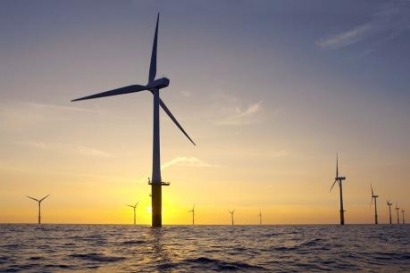
London’s CEBR has published a major new report into the economic impact of the UK’s offshore wind sector out to 2030, timed to coincide with the first ever Global Offshore Wind conference held in London earlier this month.
Two years ago, the Offshore Valuation Group measured the value of the UK’s offshore renewable energy resource and concluded that, by 2050 – by harnessing less than a third of that resource – the UK could generate the electricity equivalent of 1 billion barrels of oil a year, reduce its carbon dioxide emissions by 1 billion tonnes and create over 145,000 new jobs.
This new June 2012 CEBR/MRP report builds on that work by exploring the impact of planned investment in offshore wind electricity generating capacity in the UK. It concludes that that investment can be expected to increase UK GDP by 0.2%, and create over 45,000 full time jobs over the next three years, delivering employment and economic growth at a time of economic fragility.
It also forecasts that by 2020, the sector will double that GDP contribution to 0.4%, and the number of people employed to over 97,000.
By 2030, this GDP contribution will triple to 0.6%, and offshore wind will sustain 173,000 jobs. “These benefits will accrue from pursuing current build out rates of offshore wind. A more aggressive, but achievable, approach could see an annual 1% uplift to GDP, and the creation of up to 215,000 jobs, and in addition, the sector could deliver an increase in net exports of £22.5bn, sufficient to almost entirely plug the UK’s current balance of trade deficit,” says the CEBR.
Furthermore, a foreign trade multiplier (FTM) analysis of the impact of increasing levels of offshore wind investments and exports leads CEBR to contend that significant multiplier impacts can be expected to derive from investment in offshore wind.
For instance, while CEBR predicts that by 2020, under its Accelerated Growth scenario, investment in offshore wind will generate £8.4 billion of Gross Value Addto the UK economy, the application of their FTM model suggests that this contribution could rise to £10.5 billion.
These differences are even more marked by 2030, when the estimated difference in impact – between that suggested by the domestic and FTM multipliers – is (for employment) three times the difference estimated for 2020.
Value of wind
Commenting, Eddie O’Connor, CEO of Mainstream Renewable Power says: “The ‘Value of Offshore Wind’ to the UK is truly significant. CEBR shows that the net economic benefit to UK plc from investment in offshore wind is considerable. The foreign trade multiplier effect is of particular interest to a sector which has the potential to supply a global market. By helping the UK reduce fossil fuel imports, and by creating a new industry, offshore wind will create jobs, assist in balancing the trade deficit and boost GDP at a time of economic uncertainty.
“Later this year we will publish a companion paper which will show that offshore wind is a very attractive investment to include in a diversified, low carbon generation resource portfolio. Including a substantial amount of offshore wind will help in the achievement of the government’s long-term goals to decarbonise the UK’s electricity sector by lowering risk and cost to UK consumers.
“We have embarked on a once off transition to a sustainable economy. All forms of renewable energy, from solar energy to tidal energy, will contribute to delivering this transition in the UK. But offshore wind provides this country with a clear global comparative advantage, particularly when the UK government and industry will this week publish their strategy to reduce the cost of offshore wind to £100/MWh by 2020. CEBR’s findings underline the importance of that strategy, and the very significant potential economic benefit that this sector will deliver to the UK.”
Meanwhile, Oliver Hogan, Head of Microeconomics at CEBR and principal author of the report exaplins that “the current economic circumstances and the competitive challenges facing the UK highlight the importance of taking actions to improve the country’s trade balance. Such actions, by acting directly on the factor that is constraining growth, can be expected to have particularly important foreign trade multiplier impacts.
“It is CEBR’s contention that, given the positive impacts on the UK’s balance of trade outlined in our report, these significant multiplier impacts can be expected to derive from investment in offshore wind.”
In a recent blog, Eddie O’Connor highlights that “critics of renewable energy have argued that the provision of such schemes ‘prove’ that wind and solar energy are uneconomic, inefficient and costly. What I know, from insights gained over the last 15 years, and from evidence gathered from global markets, is that the benefits to electricity consumers or taxpayers delivered by wind and solar energy outweigh the costs”. This new report proves his point and shows that offshore wind provides this country with a clear global comparative advantage, and will assist in providing affordable electricity to consumers and enhancing the country’s energy security.
For additional information:

